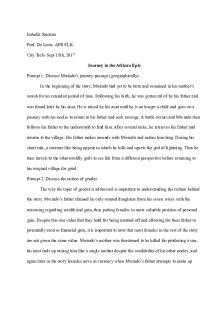The Pan African Paper Mills PDF

| Title | The Pan African Paper Mills |
|---|---|
| Author | Maggie Magu |
| Course | human resource management |
| Institution | Kiriri Women's University of Science and Technology |
| Pages | 1 |
| File Size | 43.6 KB |
| File Type | |
| Total Downloads | 33 |
| Total Views | 153 |
Summary
case study...
Description
The Pan African Paper Mills (EA) Limited was established in 1969 as a joint-venture between the government of Kenya and an Indian company, with the ownership structure of 49-51 per cent. The company supplied about 50 per cent of the total paper products consumption in the country, and had generous access to the supply of raw materials. At the time it collapsed, the paper mill employed about 2000 permanent workers and over 30,000 dependent casuals and suppliers to the factory. Early in 2009, the company began to experience difficulty in paying for recurrent production costs, such as electricity, oil and spare parts. It sought permission to increase the prices of its products, but the government declined the request. It was also unable to secure further bank loans or guarantees. In this quandary, the company approached the workers’ union and subsequently negotiated an agreement by which the workers were paid only 30 per cent of wages, while they stayed at home for 3 months, with effect from February 2009. The union willingly agreed to these proposals in the belief that the concession would help bring the company out of its financial crisis. The agreement was executed, and the workers waited to return to work thereafter. However, before the expiration of the stay at home period, the foreign partners had abandoned the factory and quietly left the country. What was unknown to the workers and other stakeholders was that the company was already in the hands of Receivers, whose advertisements in national and regional newspapers were the source of information to them and the general public that the company had failed, and worse that the foreign managers had secretly left the country. In the advertisements, the company offered for sale its stock of spare parts and other assets to the general public. Thus the over 32,000 workers and dependent suppliers suddenly became jobless. While the failure of the company to secure bank credit and its ultimate collapse might be associated with the global financial crisis, it was most probably also a case of bad management.
What management styles can be depicted from the above passage? Discuss the importance of effective communication in managing industrial relations...
Similar Free PDFs

The Pan African Paper Mills
- 1 Pages

Mills - koko
- 5 Pages

Wright Mills
- 10 Pages

Pan Bimbo
- 4 Pages

Pan Tadeusz
- 6 Pages

Journey in the African Epic
- 3 Pages

Life in the Iron Mills 3
- 8 Pages

Mills i Giddens lectura
- 10 Pages

Pan Tadeusz - omówienie
- 72 Pages

PAN Data Sheet
- 4 Pages

African History
- 5 Pages

Mills v. Wyman - Brief
- 2 Pages

Pan dulce
- 2 Pages
Popular Institutions
- Tinajero National High School - Annex
- Politeknik Caltex Riau
- Yokohama City University
- SGT University
- University of Al-Qadisiyah
- Divine Word College of Vigan
- Techniek College Rotterdam
- Universidade de Santiago
- Universiti Teknologi MARA Cawangan Johor Kampus Pasir Gudang
- Poltekkes Kemenkes Yogyakarta
- Baguio City National High School
- Colegio san marcos
- preparatoria uno
- Centro de Bachillerato Tecnológico Industrial y de Servicios No. 107
- Dalian Maritime University
- Quang Trung Secondary School
- Colegio Tecnológico en Informática
- Corporación Regional de Educación Superior
- Grupo CEDVA
- Dar Al Uloom University
- Centro de Estudios Preuniversitarios de la Universidad Nacional de Ingeniería
- 上智大学
- Aakash International School, Nuna Majara
- San Felipe Neri Catholic School
- Kang Chiao International School - New Taipei City
- Misamis Occidental National High School
- Institución Educativa Escuela Normal Juan Ladrilleros
- Kolehiyo ng Pantukan
- Batanes State College
- Instituto Continental
- Sekolah Menengah Kejuruan Kesehatan Kaltara (Tarakan)
- Colegio de La Inmaculada Concepcion - Cebu


